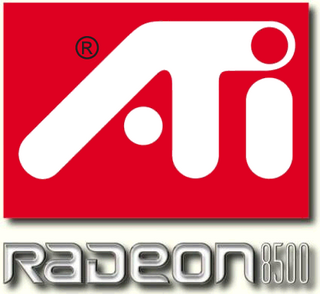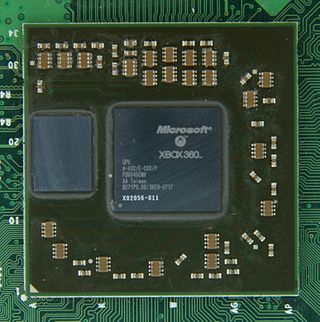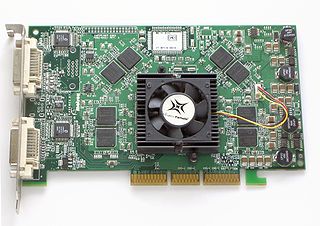
ATI Technologies Inc. was a Canadian semiconductor technology corporation based in Markham, Ontario, that specialized in the development of graphics processing units and chipsets. Founded in 1985, the company listed publicly in 1993 and was acquired by AMD in 2006. As a major fabless semiconductor company, ATI conducted research and development in-house and outsourced the manufacturing and assembly of its products. With the decline and eventual bankruptcy of 3dfx in 2000, ATI and its chief rival Nvidia emerged as the two dominant players in the graphics processors industry, eventually forcing other manufacturers into niche roles.
The PowerPC 7xx is a family of third generation 32-bit PowerPC microprocessors designed and manufactured by IBM and Motorola. This family is called the PowerPC G3 by Apple Computer, which introduced it on November 10, 1997. A number of microprocessors from different vendors have been used under the "PowerPC G3" name. Such designations were applied to Mac computers such as the PowerBook G3, the multicolored iMacs, iBooks and several desktops, including both the Beige and Blue and White Power Macintosh G3s. The low power requirements and small size made the processors ideal for laptops and the name lived out its last days at Apple in the iBook.

A graphics processing unit (GPU) is a specialized electronic circuit initially designed for digital image processing and to accelerate computer graphics, being present either as a discrete video card or embedded on motherboards, mobile phones, personal computers, workstations, and game consoles. After their initial design, GPUs were found to be useful for non-graphic calculations involving embarrassingly parallel problems due to their parallel structure. Other non-graphical uses include the training of neural networks and cryptocurrency mining.

The Wii is a home video game console developed and marketed by Nintendo. It was released on November 19, 2006, in North America, and in December 2006 for most other regions of the world. It is Nintendo's fifth major home game console, following the GameCube, and is a seventh-generation console alongside Microsoft's Xbox 360 and Sony's PlayStation 3.
The R420 GPU, developed by ATI Technologies, was the company's basis for its 3rd-generation DirectX 9.0/OpenGL 2.0-capable graphics cards. Used first on the Radeon X800, the R420 was produced on a 0.13 micrometer low-K photolithography process and used GDDR-3 memory. The chip was designed for AGP graphics cards.

The Voodoo 5 was the last and most powerful graphics card line that was released by 3dfx Interactive. All members of the family were based upon the VSA-100 graphics processor. Only the single-chip Voodoo 4 4500 and dual-chip Voodoo 5 5500 made it to market.

The R200 is the second generation of GPUs used in Radeon graphics cards and developed by ATI Technologies. This GPU features 3D acceleration based upon Microsoft Direct3D 8.1 and OpenGL 1.3, a major improvement in features and performance compared to the preceding Radeon R100 design. The GPU also includes 2D GUI acceleration, video acceleration, and multiple display outputs. "R200" refers to the development codename of the initially released GPU of the generation. It is the basis for a variety of other succeeding products.
Embedded DRAM (eDRAM) is dynamic random-access memory (DRAM) integrated on the same die or multi-chip module (MCM) of an application-specific integrated circuit (ASIC) or microprocessor. eDRAM's cost-per-bit is higher when compared to equivalent standalone DRAM chips used as external memory, but the performance advantages of placing eDRAM onto the same chip as the processor outweigh the cost disadvantages in many applications. In performance and size, eDRAM is positioned between level 3 cache and conventional DRAM on the memory bus, and effectively functions as a level 4 cache, though architectural descriptions may not explicitly refer to it in those terms.

The Xenos is a custom graphics processing unit (GPU) designed by ATI, used in the Xbox 360 video game console developed and produced for Microsoft. Developed under the codename "C1", it is in many ways related to the R520 architecture and therefore very similar to an ATI Radeon X1800 XT series of PC graphics cards as far as features and performance are concerned. However, the Xenos introduced new design ideas that were later adopted in the TeraScale microarchitecture, such as the unified shader architecture. The package contains two separate dies, the GPU and an eDRAM, featuring a total of 337 million transistors.

The Radeon R100 is the first generation of Radeon graphics chips from ATI Technologies. The line features 3D acceleration based upon Direct3D 7.0 and OpenGL 1.3, and all but the entry-level versions offloading host geometry calculations to a hardware transform and lighting (T&L) engine, a major improvement in features and performance compared to the preceding Rage design. The processors also include 2D GUI acceleration, video acceleration, and multiple display outputs. "R100" refers to the development codename of the initially released GPU of the generation. It is the basis for a variety of other succeeding products.

The Matrox Parhelia-512 is a graphics processing unit (GPU) released by Matrox in 2002. It has full support for DirectX 8.1 and incorporates several DirectX 9.0 features. At the time of its release, it was best known for its ability to drive three monitors and its Coral Reef tech demo.

Broadway is the codename of the 32-bit central processing unit (CPU) used in Nintendo's Wii home video game console. It was designed by IBM, and was initially produced using a 90 nm SOI process and later produced with a 65 nm SOI process.

The RSX 'Reality Synthesizer' is a proprietary graphics processing unit (GPU) codeveloped by Nvidia and Sony for the PlayStation 3 game console. It is based on the Nvidia 7800GTX graphics processor and, according to Nvidia, is a G70/G71 hybrid architecture with some modifications. The RSX has separate vertex and pixel shader pipelines. The GPU makes use of 256 MB GDDR3 RAM clocked at 650 MHz with an effective transmission rate of 1.3 GHz and up to 224 MB of the 3.2 GHz XDR main memory via the CPU . Although it carries the majority of the graphics processing, the Cell Broadband Engine, the console's CPU, is also used complementarily for some graphics-related computational loads of the console.

Microsoft XCPU, codenamed Xenon, is a CPU used in the Xbox 360 game console, to be used with ATI's Xenos graphics chip.

Gekko is a superscalar out-of-order 32-bit PowerPC microprocessor custom-made by IBM in 2000 for Nintendo to use as the CPU in their sixth generation game console, the GameCube, and later the Triforce Arcade Board.
PICA200 is a graphics processing unit (GPU) designed by Digital Media Professionals Inc. (DMP), a Japanese GPU design startup company, for use in embedded devices such as vehicle systems, mobile phones, cameras, and game consoles. The PICA200 is an IP Core which can be licensed to other companies to incorporate into their SOCs. It was most notably licensed for use in the Nintendo 3DS.
The eighth generation of video game consoles began in 2012, and consists of four home video game consoles: the Wii U released in 2012, the PlayStation 4 family in 2013, the Xbox One family in 2013, and the Nintendo Switch family in 2017.

Espresso is the codename of the 32-bit central processing unit (CPU) used in Nintendo's Wii U video game console. It was designed by IBM, and was produced using a 45 nm silicon-on-insulator process. The Espresso chip resides together with a GPU from AMD on an MCM manufactured by Renesas. It was revealed at E3 2011 in June 2011 and released in November 2012.

The Xbox technical specifications describe the various components of the Xbox video game console.

MoSys, Inc., originally Monolithic System Technology (MoST), was a fabless semiconductor design company founded in 1991. The company primarily designed memory chips and were especially known for their Multibank DRAM and 1T-SRAM technologies—the latter used on Nintendo's Wii and GameCube video game consoles.















